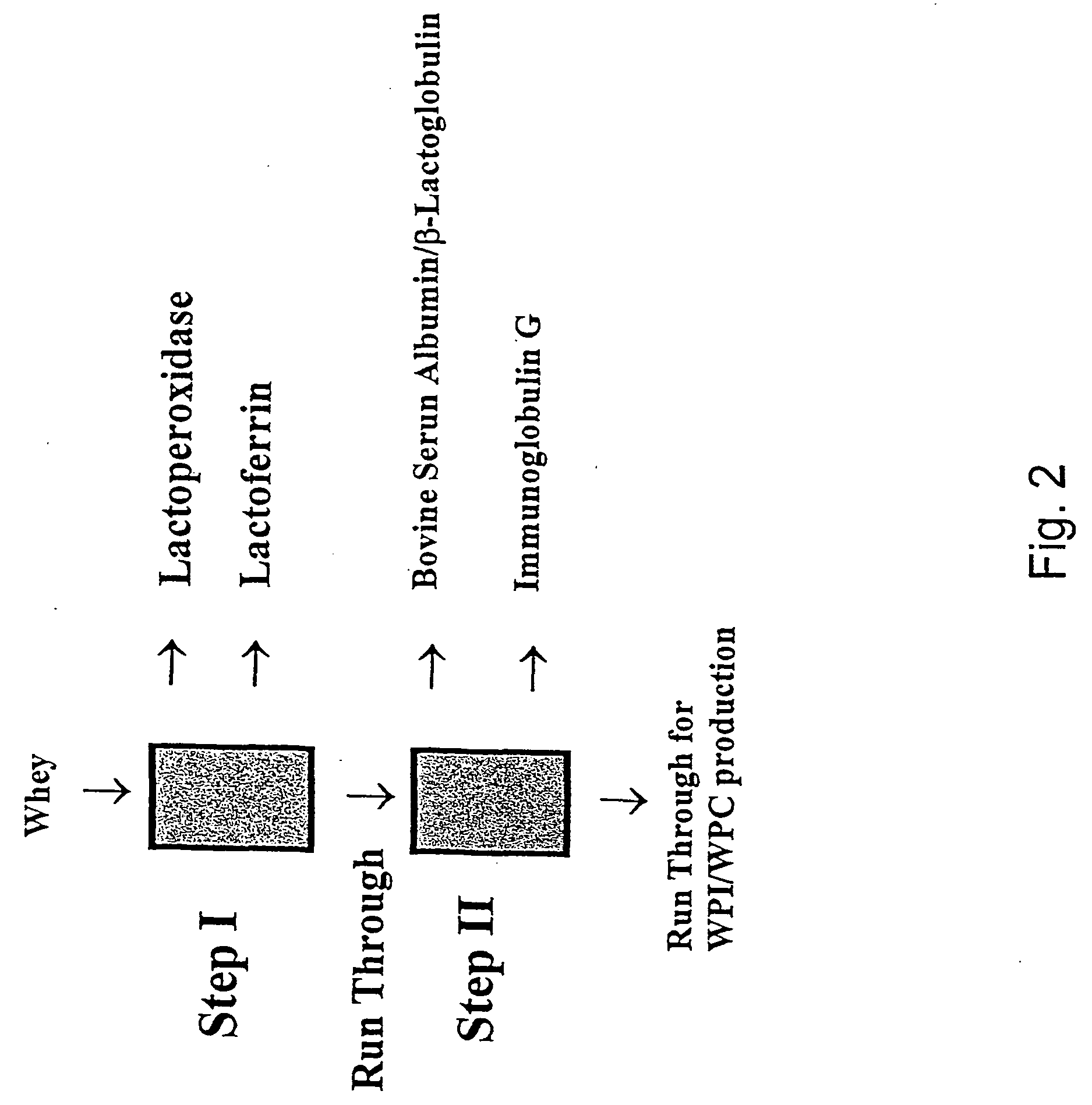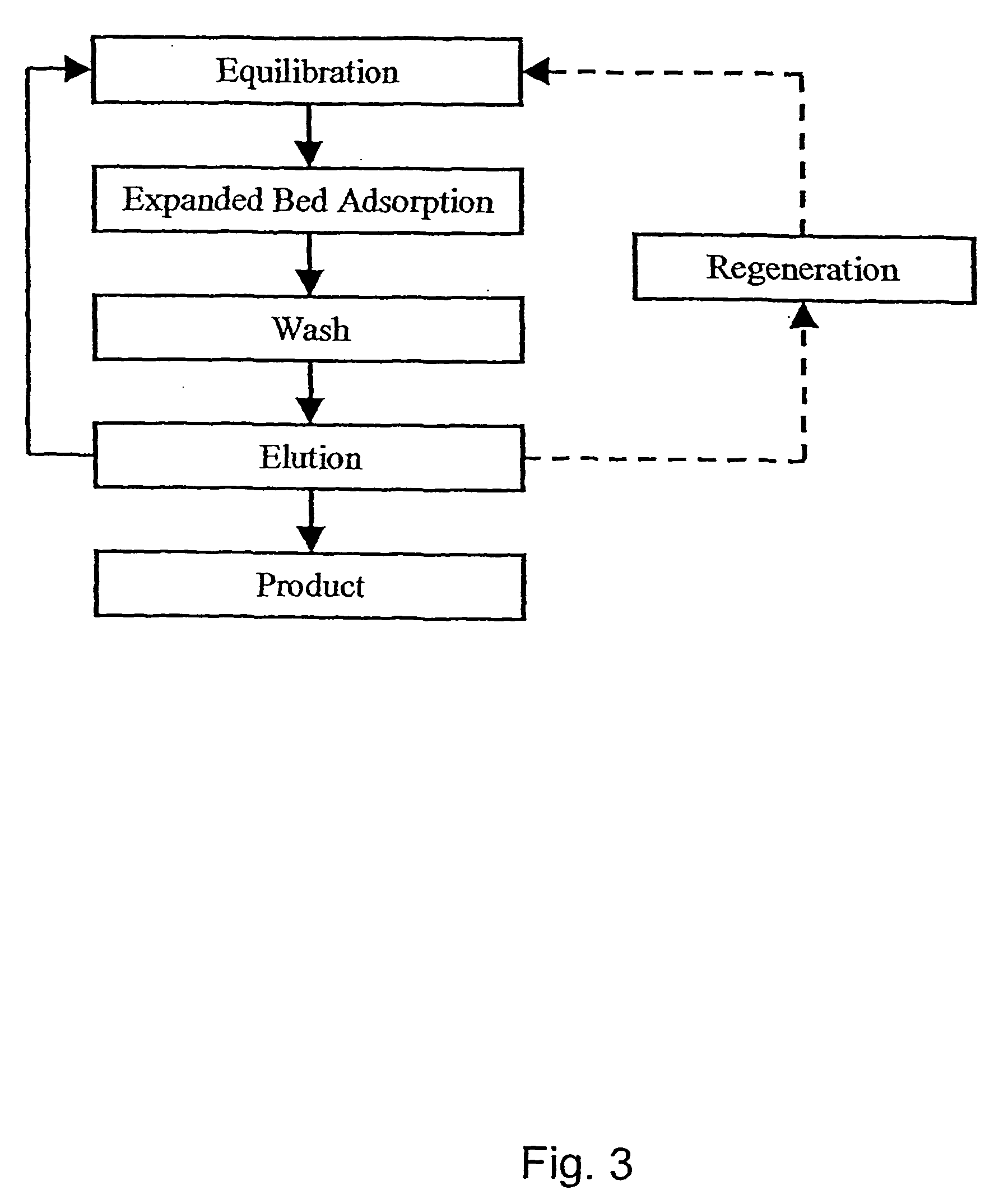Fractionation of protein containing mixtures
a technology of protein containing mixture and fractionation method, which is applied in the direction of peptide sources, carrier-bound/immobilised peptides, ion-exchangers, etc., can solve the problems of increased back-pressure, media loss in column effluent, and the inability to meet the density requirements per se of synthetic organic polymers and copolymers typically based on acrylic monomers used for chromatographic purification of proteins in packed bed columns
- Summary
- Abstract
- Description
- Claims
- Application Information
AI Technical Summary
Benefits of technology
Problems solved by technology
Method used
Image
Examples
example 1
Characteristics of an EBA Adsorbent.
This example describe the features of the adsorbent from UpFront Chromatography used in Example 2-19.
The term “UpFront Stainless Steel-Agarose” refers to adsorbent particles produced by an emulsification process as conceptually described in the description. They comprise a core material consisting of stainless steel beads (1-PSR 2, Anval, Sweden) sized in the range 22-44 μm. A layer of agarose (4% agarose) surrounds the stainless steel core bead(s). The adsorbent particle population is sieved to get a particle size distribution in the range of 30-120 μm (see FIG. 4). The mean particle diameter has been determined to be 65 μm by a microscopic examination combined with image processing.
The particle population of the adsorbent comprises both composite particles having a pellicular structure (i.e. one steel bead embedded in the agarose polymeric phase) as well as conglomerate particles having more than one steel bead inside the agarose phase Th...
example 2
Epoxy Activation and Cross-Linking of “UpFront Stainless Steel-Agarose” with a Poly-Epoxy Compound.
The adsorbent “UpFront Stainless Steel-Agarose” described in example 1 was chemically activated and cross-linked by the use of a polymeric epoxy compound “GE 100”, HS code 2910 90 00, CAS-no.: 90529-77-4 / 25038-04-4 from RASCHIG GmbH, Ludwigshafen, Germany following the procedure below:
25 L of wet but suction drained “UpFront Stainless Steel-Agarose” was mixed with 20 L demineralised water, 10 kg sodium sulphate (water free), 2.5 L 32.5% (w / w) sodium hydroxide and 1.25 L “GE 100”. The suspension was thoroughly mixed at room temperature for 1 hour. At this time another 1.25 L “GE 100” was added to the stirred suspension, followed by mixing at room temperature for another hour. The addition of 1.25 L “GE 100” followed by mixing for one hour was repeated for another three times, so that the suspension totally had been added 5×1.25 L “GE 100”.
Following reaction with “GE 100” the adso...
example 3
Preparation of a Sulfonic Acid Ion Exchanger with Butane Sultone.
The “GE-100” activated and cross-linked adsorbent prepared in Example 2 was further reacted with butane sultone to prepare a cation exchanger comprising sulfonic acid groups.
25 L “GE 100” reacted “UpFront Stainless Steel-Agarose” from Example 2 was washed on a suction filter with 50 L 32.5% w / w sodium hydroxide, followed by draining by gentle suction. The highly basic adsorbent cake was transferred into a jacketed and termostated reaction tank and added 15 L deionised water. The adsorbent was suspended in the aqueous phase by gentle stirring and the suspension was then heated to 70° C.
The suspension was then added 1 kg sodium dodecyl sulfate, which was dissolved under gentle stirring. While continuing stirring and maintaining the temperature close to 70° C. 1,4-butane sultone, code 13671, CAS No.: 1633-83-6, ORGANICA, Wolfen, Germany, was added in 8 portions each of 1.56 L butane sultone. In between each additio...
PUM
| Property | Measurement | Unit |
|---|---|---|
| particle size | aaaaa | aaaaa |
| particle density | aaaaa | aaaaa |
| density | aaaaa | aaaaa |
Abstract
Description
Claims
Application Information
 Login to View More
Login to View More - R&D
- Intellectual Property
- Life Sciences
- Materials
- Tech Scout
- Unparalleled Data Quality
- Higher Quality Content
- 60% Fewer Hallucinations
Browse by: Latest US Patents, China's latest patents, Technical Efficacy Thesaurus, Application Domain, Technology Topic, Popular Technical Reports.
© 2025 PatSnap. All rights reserved.Legal|Privacy policy|Modern Slavery Act Transparency Statement|Sitemap|About US| Contact US: help@patsnap.com



